Teaching Practice Experience
During my teaching practice, I had the opportunity to instruct students across various educational levels—elementary, middle school, and university. Initially, I felt nervous, especially when preparing lessons for university students. However, as I conducted each class, my confidence grew. The students were engaged and seemed to enjoy the lessons, which made me feel proud and happy. This experience taught me that with preparation and effort, I can effectively teach students of different ages.
My weekly schedule was quite dynamic. Four times a week, I attended classes that enriched my teaching methodologies. Subjects like drama pedagogy introduced me to innovative ways of engaging students through performance and storytelling. Courses in American history expanded my content knowledge, allowing me to bring diverse perspectives into the classroom. These sessions not only enhanced my academic understanding but also provided practical strategies to apply during my teaching practice.
Exploring the City in My Free Time
In my free time, I enjoyed exploring the city. I often visited local parks, which were beautiful and peaceful places to walk around. One of the highlights was visiting the city zoo, where I saw polar bear cubs that were born in November 2024. During spring break, I traveled to Budapest, the capital city, and also took a day trip to Vienna, Austria, which was only three hours away. These trips allowed me to experience new cultures and create unforgettable memories.
Comparing Educational and Work Cultures
Comparing educational and work cultures between Finland and Hungary reveals distinct differences that have significantly influenced my teaching experience.
Educational Culture
In Finland, the educational environment emphasizes open communication and honesty. Students are encouraged to express their thoughts and provide feedback, fostering a culture of mutual respect and continuous improvement. Teachers are viewed as facilitators, guiding students to develop critical thinking skills and take ownership of their learning.
Conversely, in Hungary, I observed that students often hesitate to share their opinions openly. There seems to be a fear of making mistakes or facing embarrassment, which can hinder active participation. While students show great respect for their teachers, this reverence sometimes translates into reluctance to engage in discussions or challenge ideas. This contrast highlights the importance of creating a supportive environment where students feel comfortable expressing themselves without fear of judgment.
Work Culture
The Finnish work culture is characterized by trust-based leadership, flexibility, and a strong emphasis on employee well-being. Work-life balance is highly valued, and there is a focus on efficiency rather than long working hours. Employees are trusted to manage their tasks independently, which fosters a sense of responsibility and autonomy.
In Hungary, the work environment tends to be more hierarchical. Decision-making often resides with higher management, and there is a greater emphasis on formal procedures and protocols. While this structure ensures clarity in roles and responsibilities, it may limit opportunities for employees to contribute ideas or take initiative. Encouraging a more collaborative approach could enhance innovation and employee engagement.
Experiencing these differing educational and work cultures has broadened my perspective and underscored the value of adaptability in teaching and professional settings. By integrating the openness and trust found in Finnish culture with the structured approach of Hungarian systems, it is possible to create a balanced environment that promotes both efficiency and inclusivity.
Overall, this experience has been incredibly valuable. It not only improved my teaching skills but also broadened my understanding of different cultures and educational systems. I am grateful for the opportunity to learn and grow both professionally and personally.






Comments